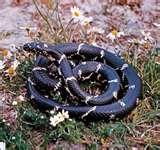|
|
Insecticides commonly used on Reptiles
Pyrethroids - Fairly Safe
Pyrethroids are man-made versions of the natural insecticide
of the Chrysanthemum flower, pyrethrum. Pyrethroids are much
less toxic than many other insecticides, and kill mites much
more quickly and for a longer period between applications.
You will find sprays that contain Pyrethroids such as
permethrin at most pet supply stores. Or your veterinarian
may be able to provide such a spray for you. If your pet
seems weak or anemic, your herp vet should see it before any
chemicals are administered in any event, to make sure it is
strong enough for the treatment.
To treat your turtle or tortoise with a Pyrethroids spray,
cover its eyes to protect them, and then spray a small
amount on the skin where each leg meets the body. If your
reptile is a snake or lizard, take the animal and its food
and water dishes out of the vivarium, spray the substrate,
and make sure everything has dried completely before putting
your reptile and its food and water back into the cage.
Ivermectin and Fenbendazole - Risky but useful if the
situation requires
Ivermectin can be given orally, by injection, or a diluted
solution can be sprayed on the snake or lizard, but in some
cases it is not as effective as Pyrethroids. Do NOT use
ivermectin in turtles or tortoises, and only ask your
veterinarian to give it to other reptiles if the animal is
not small or weak, as the required dosage is a near-fatal
strength and can cause paralysis or blindness. Some
experienced reptile keepers recommend that Fenbendazole be
used instead, as it is much less toxic. Never, repeat,
never! give Ivermectin to any turtle or tortoise, it will
kill them.
Pest strips or flea collars designed for cats or dogs - Not
recommended.
Some people have tried killing external parasites on their
reptiles by placing pieces of insect pest strips or pet flea
or tick collars into or on top of the vivarium or cage. This
is a dangerous practice, as reptiles are all very sensitive
to chemicals, and some pest strips and flea collars contain
organophosphates, which will kill reptiles.

Cyfluthrin
Cyfluthrin is recommended by some experienced tortoise
keepers to treat a tortoise area where ticks are a problem.
Prevention
Since prevention is always the best cure, be sure to:
1. Most mite and tick infestations come into a reptile house
on new arrivals. Carefully check and then quarantine and
watch for at least one month any new reptile you add to your
collection, before exposing your other pets to it.
Also be careful not to accidentally carry any pests from the
new animal to your other pets. Care for the new reptile (s)
last, and wash carefully afterward, ticks are adept at
traveling incognito.
2. Regularly clean your reptile living quarters, moving the
animals to dedicated isolation cages and disinfecting the
cage or tank with a chlorine bleach solution mix (Mix a
solution of one part bleach to eight parts water.)
3. Check each animal over visually on a regular schedule.
That way you can watch not only for pests but for weight
loss or gain, proper shedding, injuries and the like. Your
reptile is depending on you.
|